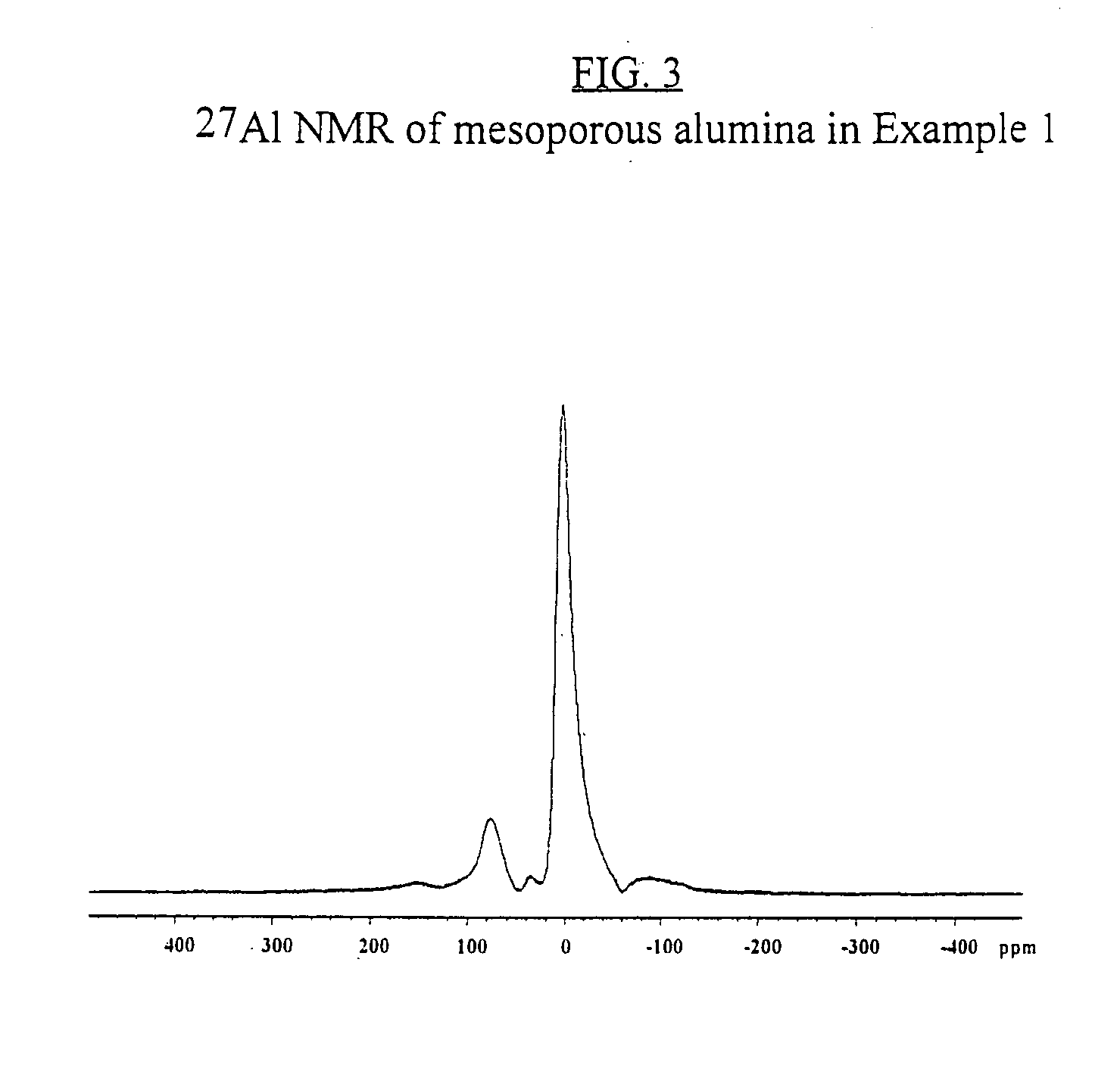Mesoporous aluminum oxide, preparation and use thereof
a technology of aluminum oxide and mesoporous materials, which is applied in the field of mesoporous materials, can solve the problems of difficult to adjust the porosity of the resulting materials, and achieve the effect of cost-effectiveness
- Summary
- Abstract
- Description
- Claims
- Application Information
AI Technical Summary
Benefits of technology
Problems solved by technology
Method used
Image
Examples
example 1
[0092] Sixty-five (65) parts by weight of isopropanol and 85 parts of ethanol were added to a vessel with 53 parts of aluminum isopropoxide. After stirring at 50° C. for about 4 hours. 50 parts of tetraethylene glycol (TEG) were added drop-wise while stirring. After stirring for another 4 hours, 10 parts of water together with 20 parts of isopropanol and 18 parts of ethanol were added under stirring. After half an hour of stirring, the mixture became a white suspension, which was then aged at room temperature for 48 hours, and then dried in air at 70° C. for 20 hours, to obtain a solid gel. This solid gel was heated in a pressurized, heated vessel at 160° C. for 2.5 hours and finally calcined at 600° C. for 6 hours in air to produce mesoporous aluminum oxide.
[0093]FIG. 1 shows the XRD pattern of the resulting calcined mesoporous aluminum oxide. There is an intensive peak around 1.6° in 2?, characteristic of meso-structured materials. FIG. 2 shows the pore size distribution narrowly...
examples 2-6
[0094] The same synthesis mixture of Example 1 was prepared, aced and dried under the same conditions as described above in Example 1. The dried gel was then divided into five parts, and each part was transferred into a separate pressurized, heated vessel. These five pressurized vessels were heated at 160° C. for 3, 4.75, 6.25. 8.0 and 10 hours. respectively, corresponding to Examples 2, 3, 4, 5, and 6. Finally the samples were calcined at 600° C. for 6 hours in air.
[0095] Table 1 below shows the mesoporosity of the materials based on nitrogen adsorption. It is clear that mesopore sizes increase with the time of heating, whereas surface areas decrease. In this way, the mesoporosity can be easily tailored.
TABLE 1Tuning mesoporosity of aluminum oxide by heating the driedgel in autoclaves.HeatingSurface areaAverage porePore volumeExampletime (hr)(m2 / g)size (nm)(cm3 / g)234314.70.6234.754295.10.6546.254215.30.67584105.40.676103815.70.69
[0096]FIG. 4 shows the XRD patterns of the materia...
examples 7-10
[0097] The same synthesis mixture of Example 1 was prepared, aged and dried under the same conditions as Example 1. The dried gel was then divided into four parts and each part was transferred into a separate pressurized, heated vessel. These four pressurized vessels were heated at 120° C. for 4, 6, 11 and 15 hours, respectively, corresponding to Examples 7, 8, 9, and 10. Finally the samples were calcined at 600° C. for 6 hours in air.
[0098] Table 2 below shows the mesoporosity of the materials based on nitrogen adsorption.
TABLE 2Tuning mesoporosity of aluminum oxide by heating the driedgel in autoclaves.HeatingSurface areaAverage porePore volumeExampletime (hr)(m2 / g)size (nm)(cm3 / g)744724.00.61864684.20.609113896.20.711015386181.7
[0099] Table 2 shows again that the mesoporosity of the materials can be tuned by varying the heating time. Compared to Examples 2-6, it is clear that heating at lower temperatures in the pressurized, heated vessel led to higher surface areas in the res...
PUM
| Property | Measurement | Unit |
|---|---|---|
| 2θ | aaaaa | aaaaa |
| operating temperature | aaaaa | aaaaa |
| pressure | aaaaa | aaaaa |
Abstract
Description
Claims
Application Information
 Login to View More
Login to View More - R&D
- Intellectual Property
- Life Sciences
- Materials
- Tech Scout
- Unparalleled Data Quality
- Higher Quality Content
- 60% Fewer Hallucinations
Browse by: Latest US Patents, China's latest patents, Technical Efficacy Thesaurus, Application Domain, Technology Topic, Popular Technical Reports.
© 2025 PatSnap. All rights reserved.Legal|Privacy policy|Modern Slavery Act Transparency Statement|Sitemap|About US| Contact US: help@patsnap.com



